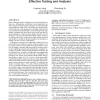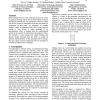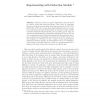1123 search results - page 63 / 225 » GUI Testing Techniques Evaluation by Designed Experiments |
SIGSOFT
2008
ACM
14 years 9 months ago
2008
ACM
Many testing and analysis techniques have been developed for inhouse use. Although they are effective at discovering defects before a program is deployed, these techniques are oft...
FMICS
2006
Springer
14 years 4 days ago
2006
Springer
Abstract. The design flow of systems-on-a-chip (SoCs) identifies several abstraction levels higher than the Register-Transfer-Level that constitutes the input of the synthesis tool...
ECBS
2007
IEEE
14 years 2 months ago
2007
IEEE
Most existing work on t-way testing has focused on 2-way (or pairwise) testing, which aims to detect faults caused by interactions between any two parameters. However, faults can ...
PROFES
2001
Springer
14 years 28 days ago
2001
Springer
New information is obtained by research and disseminated by papers in conferences and journals. The synthesis of knowledge depends upon social discourse among the experts in a give...
CADE
2011
Springer
12 years 8 months ago
2011
Springer
Deduction modulo is a generic framework to describe proofs in a theory better than using raw axioms. This is done by presenting the theory through rules rewriting terms and proposi...



